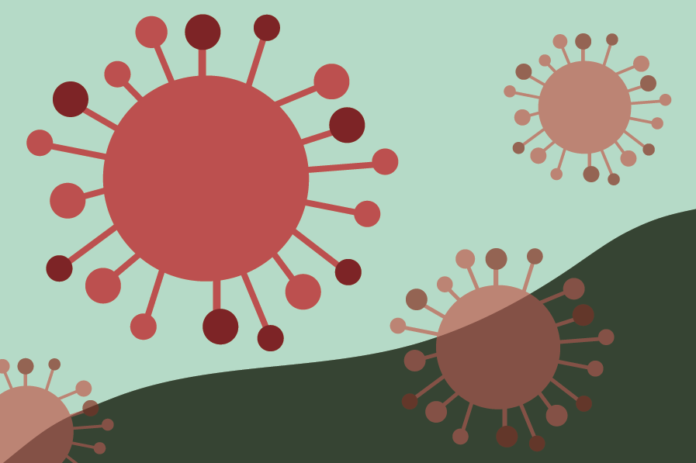As the upward trend of omicron cases is seeming to decline, experts say it is important to stay cautious while returning in-person classes
By MONICA MANMADKAR — science@theaggie.org
With students, faculty and other UC Davis members coming back to campus for in-person learning, it is still important to keep COVID-19 in mind and take the necessary precautions to keep everyone safe. UC Davis health professionals emphasize the necessity of keeping masks on and testing in a timely manner.
In interviews with The California Aggie, UC Davis public health experts, infectious disease professionals and epidemiologists answered some common questions and noted measures that everyone should take to continue staying safe.
What is the omicron variant and what makes it different?
Like any virus, COVID-19 evolves and mutates, which allows the strains to continue infecting people at increasing rates, according to Dr. Dean Blumberg, the chief of pediatric infectious diseases at UC Davis Children’s Hospital. The original strain has 32 mutations, which is much less compared to the omicron variant which has over 50 more mutations. With these mutations, the virus can more easily attach to cells, hence initiating infection.
“Some of these mutations result in stronger binding of the spike protein to our receptors, some enhance viral replication, and some avoid neutralizing antibodies from infection of immunization with previous strains,” Blumberg said via email.
Is the omicron variant more transmissible and why?
Since the omicron variant can bind easily to receptors and cause infection, the variant is more transmissible. Blumberg explained how stronger binding to the cell’s receptors leads to a higher viral replication rate and thus higher virus concentrations. This results in omicron being two to five times more transmissible than the former delta variant.
“With the virus’ rapid replication, the mutation rate is much higher and so is the evolution of the virus,” said Dr. Bradley H. Pollock, a professor of epidemiology and chair of the Department of Public Health Sciences. “Omicron is one of the results of the mutations that the original virus made and is continuing a prominent variant due to its evolution into being so contagious.”
Why should people still continue to get tested even if the symptoms of omicron are milder?
The omicron variant is extremely infectious. Dr. Lorena Garcia, an epidemiologist and professor in the Department of Public Health Sciences, explained that although people may not feel the effects of the symptoms, they can still infect others such as immunocompromised individuals. Those who are unvaccinated and not boosted are also more susceptible to severe symptoms than the vaccinated population.
“If you infect someone who is unvaccinated, that person can go on to have severe outcomes, including hospitalization, severe illness and even death,” Garcia said.
Garcia also detailed that individuals have died due to omicron across age groups. Hence, it is important that individuals get tested, even if they are asymptomatic, and if they test positive, to quarantine and inform those with whom they’ve had close contact. Garcia added that the viral load of omicron is much higher than delta and the other variants, which is why someone with omicron is more infectious.
How long are omicron symptoms contagious? Are the symptoms different?
“For all intents and purposes, you may be seeing maybe not the same frequency and effect of the symptoms with the omicron variant,” Pollock said. “However, the core symptoms remain the same — loss of smell, coughing, fever, etc.”
In terms of the timeframe, Blumberg described that people may still be contagious for up to 10 days from the onset of symptoms. But they are no longer considered infectious after that if they are clinically improving and do not have a fever without using fever-reducing medications.
What type of masks should students wear? Is it okay to keep using cloth masks?
Pollock explained that the highest efficacy mask would be N95s or equivalent masks, followed by surgical masks and then the cloth masks without a filter.
“The surgical masks are much better than the cloth masks, but they would be even more effective if you can put a cloth mask over it,” Pollock said.
The cloth masks keep the surgical masks tightly in place on the face, firmly covering the nose and mouth completely and avoiding any type of leakage around the facial area.
What does this surge with the omicron variant tell us about future COVID-19 strains and their effects on the community?
Pollock explained that all omicron can tell us about the virus is that we hope that future variants are milder, and we hope that there will be less hospitalization.
“However, it is extremely important for everyone to get vaccinated and boosted. With those antibodies, infected individuals will have more mild symptoms and will most likely not be in danger,” Garcia said.
In addition, we do know that more viral transmission leads to more replication, which increases the chances for variants to arise. That is why it is so important to increase efforts to vaccinate more people worldwide, Blumberg said.
As a whole, experts say it is important to stay safe and wear masks even with declining cases. The omicron variant is still in the community and is extremely transmissible, they said.
Written by: Monica Manmadkar — science@theaggie.org





